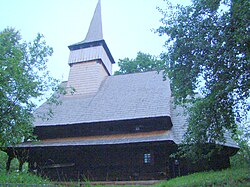Romanian ethnicity indicates genetic origins in the country of Romania. The Romanian people are unusual within the Balkans in so far as they are not extensively related to the various groups which migrated into the region during the great migration period between the third and tenth centuries. These groups, of which the Slavs and the Bulgars were the most prominent, are the descendants of the great bulk of the people who live in countries like Czechia, Slovakia, Croatia, Serbia and Bulgaria. But the Romanian people managed to withstand these incursions to a certain extent, meaning that Romanians today, so far as is possible, are understood to be more directly descended from the people who lived here in Roman times, notably the Dacians and the Getae. Clearly, though, ethnic intermarriage over centuries has confused this situation, with people such as the Vlachs who arrived in the ninth and tenth centuries impacting on the ethnic makeup of the Romanian people. Nearly 90% of the people of Romania identify as Romanian. The largest minority are Hungarians, who make up 6% of the population, primarily in the west of the country.[1] Romani people are another significant minority, while the country’s proximity to Ukraine has ensured that in the space of just over a year following the Russian invasion of Ukraine in 2022, approximately 100,000 people have made Romania their home.[2]
Research your ancestors on MyHeritage
Romanian history

The eastern coastal regions of what is now Romania were well-known to the civilizations of the Mediterranean during the first millennium BCE and the port of Tomis (modern-day Constanta) was something of a frontier port for the Romans by the late first century CE. It was to here that Emperor Caesar Augustus famously banished the love poet Ovid in 8 CE. A century later, Emperor Trajan conquered the wider region, which was inhabited by the Dacians and the Getae, and formed it into the province of Dacia. Trajan’s famous column in Rome commemorates the campaign.[3]
Dacia evidently became high Romanized, so much so that Latin became dominant here, unlike the majority of the provinces in the east of the Roman Empire where Greek remained the lingua franca. It was also one of the only areas of the Balkans that withstood the encroachments of the Slavs and Bulgars as they invaded the Balkans from the sixth century onwards. Consequently, the Dacia region, which would become known as Romania over time to acknowledge the many ways in which it kept elements of its old Roman identity, retained much of its old ethnic makeup.
During the High Middle Ages newcomers such as the Cumans and Pechenegs who established confederacies north of the Black Sea in modern-day Ukraine made incursions southwards into what is now Romania. Other groups such as the Vlachs or Wallachians also impacted on the ethnic makeup of the region. To further compound matters Romania, often also referred to in late medieval times as Transylvania or Wallachia, became dominated by numerous foreign powers over these centuries, eventually becoming subject to the Ottoman Turks in the sixteenth century. This period produced a notorious ruler as well, Vlad III, better known as Vlad the Impaler, who ruled Wallachia intermittently between the 1440s and the 1470s and is believed to have been a partial inspiration for Bram Stoker’s Dracula.[4]
In the middle of the nineteenth century Romanian nationalists sought to take advantage of the weakness of the Ottoman Empire to achieve their own state again. By 1859 the two principalities of Moldavia and Wallachia had largely achieved independence and in 1881 these amalgamated into the Kingdom of Romania. The kingdom entered the First World War belatedly against the Central Powers, but gained in the aftermath of the conflict from having done so by acquiring Bessarabia. Romania allied with Nazi Germany early on in the Second World War and contributed more men than any country other than Germany to the Axis invasion of the Soviet Union in 1941. In the aftermath of the conflict the country fell into the Soviet communist bloc, but under Nicolae Ceaușescu, the brutal dictator of the country between 1965 and 1989, relations even with Moscow deteriorated. Since the early 1990s Romania has seen liberalization and economic development.[5]
Romanian culture

Romania is a highly religious country down to the present day, practicing its own form of Eastern Orthodoxy. Consequently, religious holidays and other ceremonies set the pace of Romanian life in many significant ways. The country has a strong literary tradition stretching back to the eighteenth and nineteenth centuries and has produced numerous internationally recognized authors, notably Elie Wiesel and Herta Muller. Classical music is also prominent here and Bucharest is one of Europe’s leading cities in this respect, particularly the performances held at the Athenaeum in the city.[6] The country’s position on the crossroads between competing cultures and empires in centuries gone by has resulted in a sophisticated architecture and there are nine sites throughout the country which are UNESCO World Heritage sites, notably the seventeenth-century Wooden Churches of Maramureş.[7]
Romanian languages
Romanian is the official language of Romania. It has one of the most peculiar histories of any European language in that it is a Romance language derived from Latin, an oddity in Eastern Europe. Typically speaking, Greek was the lingua franca of the Eastern Roman Empire, so when the Roman Empire began to collapse in the fourth and fifth centuries CE, the Romance languages which emerged as bowdlerized versions of Latin were restricted to the western provinces. They subsequently evolved into the modern-day languages of French, Italian, Spanish, Portuguese, Occitan and Catalan. Romanian is a complete outlier in that it is also a Roman language derived from Latin, but isolated in Eastern Europe as such. This is owing to the fact that Dacia, the Roman province which corresponds with Romania today, did not have an extensive tradition of speaking Greek when it was conquered in the early second century CE. The people here consequently adopted Latin to a great extent and the language was retained thereafter, though Romanian has been influenced by the Slavic languages which are spoken in surrounding regions, as well as the Dacian tongue which was used here prior to the arrival of the Romans.[8] Romanian is spoken by just over 90% of the population of Romania as their primary language. Approximately 6% of the population are native Hungarian speakers, while Romani, German and Ukrainian are also significant minority languages.[9]
Explore more about ethnicity estimates
- MyHeritage DNA at MyHeritage
- Ethnicities around the world at MyHeritage
- What Is My Ethnicity? How MyHeritage Estimates Ethnicities at MyHeritage Knowledge Base
- Where's My Ethnicity?!: Why An Ethnicity Might Not Show Up In Your DNA (and How To Find Evidence Of It Anyway) at MyHeritage Knowledge Base
References
- ↑ https://eurydice.eacea.ec.europa.eu/national-education-systems/romania/population-demographic-situation-languages-and-religions
- ↑ https://www.bbc.com/news/world-60555472
- ↑ https://www.thecollector.com/emperor-trajan-dacian-war/
- ↑ https://www.romanianhistoryandculture.com/vlachspechenegscumans.htm
- ↑ https://www.bbc.com/news/world-europe-17776876
- ↑ https://starkconductor.com/where-circus-politics-and-music-meet-the-bucharest-athenaeum/
- ↑ https://whc.unesco.org/en/list/904
- ↑ https://linguistics.byu.edu/classes/Ling450ch/reports/romanian.html
- ↑ https://blogs.lse.ac.uk/europpblog/2021/11/24/romanias-hungarian-problem-a-minority-caught-between-integration-and-self-segregation/


